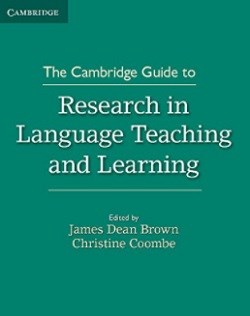Research in Language Teaching and Learning, Cambridge University Press 2015
 Research in Language Teaching and Learning
Research in Language Teaching and Learning
James Dean Brown and Christine Coombe (Editors)
Cambridge University Press 2015
There has been a steady increase since the late 1980s of publications addressing research in the fields of language teaching/learning and Applied Linguistics.
These range from James Dean Brown (1988) and David Nunan (1992) to more recent books by Zoltan Dörnyei, Graeme Porte and Brian Paltridge.
Research in Language Teaching and Learning, in the Cambridge Guide series, is a new and comprehensive analysis of what research in this field constitutes and how it can best be approached.
Over the course of its 36 chapters the book provides a clear framework and solid foundation for any current or potential language teaching researchers.
This book is aimed at a wide range of readers – it has relevance for preservice or in-service language teachers interested in research as well as those who may be following a course in research methods on undergraduate and postgraduate degree programmes.
The editors describe their intended audience as being ‘students of research’ and they provide extensive coverage of core areas by contemporary experts.
They aim to not only to give an overview of research methods and practical advice on how to improve the effectiveness of research but also to help fashion critical consumers of research.
The chapters are arranged into four main sections: Primary Considerations, Getting Ready, Doing the Research and Research Contexts.
There is a standard ‘feel’ to all of the chapters.
Each has an introduction, background information, notes on practical applications, a conclusion, discussion questions and list of references for further reading.
The four sections also have a brief preamble from the editors and a number of more general preview questions to direct attention to some of the topics elaborated on in the chapters that follow.
There are contributions from experts such as Anne Burns, Peter Stanfield, Andy Curtis, Paul Kei Matsuda and Salah Troudi.
In terms of its strengths, I found this publication to be wide-ranging and topical.
It is easy to navigate and has a clear and logical organisation.
Most chapters address ‘practical applications’ and there is a strong link between theory and practice throughout.
The discussion questions raise interesting issues and the reference sections are comprehensive and up-to-date.
What stands out for me is the fact that so much information has been condensed into 300 pages and in a manner which avoids complication yet achieves depth.
There are a number of stand-out chapters for me personally.
As a language teacher currently involved in some small-scale research, I was interested by the final section on research contexts, which gives an overview of language teacher research conducted over six continents – very useful for establishing what is trending in terms of subject matter and for getting a flavour of some of the methods used by different researchers.
Sometimes we have an idea of the general area we would like to research but struggle to pare the topic down.
Taking note of what other people are researching can help focus one’s own research.
There is also an interesting chapter on teacher research.
Simon Borg outlines some of the problems and obstacles faced by practitioners and touches on the multiple ways in which ‘research’ can be interpreted by language teaching professionals.
He also summarises areas that need to be addressed if teacher research is to be promoted and these can include sometimes considerable attitudinal, physical and technical barriers.
I also homed in on the related chapter dealing with action research (not synonymous with teacher research) and found it very thought-provoking.
Anne Burns provides a succinct overview and highlights its dynamic nature while also pointing out that it has been maligned in some quarters due to a perceived lack of rigour.
Another chapter I enjoyed was on ‘mixed methods research’.
This term has only really surfaced in the literature over the past decade.
There are, however, quite a few contemporary studies claiming to be mixed methods research but, as James Dean Brown points out, the term is often confused with ‘multimethods research’.
Brown, not without some humour, gives concrete examples of mixed methods research and his overview is a refreshing take on a seemingly complex topic.
On the negative side. I found the section on Reporting Findings to be somewhat ‘thin’ and if I were interested in having a better idea of how to present or publish research, I would need further guidance.
After all, research needs to be shared if we are to advance advancing knowledge or improve current practice.
References
Brown J D (1988) Understanding Research in Second Language Learning. Cambridge: Cambridge University Press.
Nunan D (1992) Research Methods in Language Learning. Cambridge: Cambridge University Press.

Comments
Write a Comment
Comment Submitted